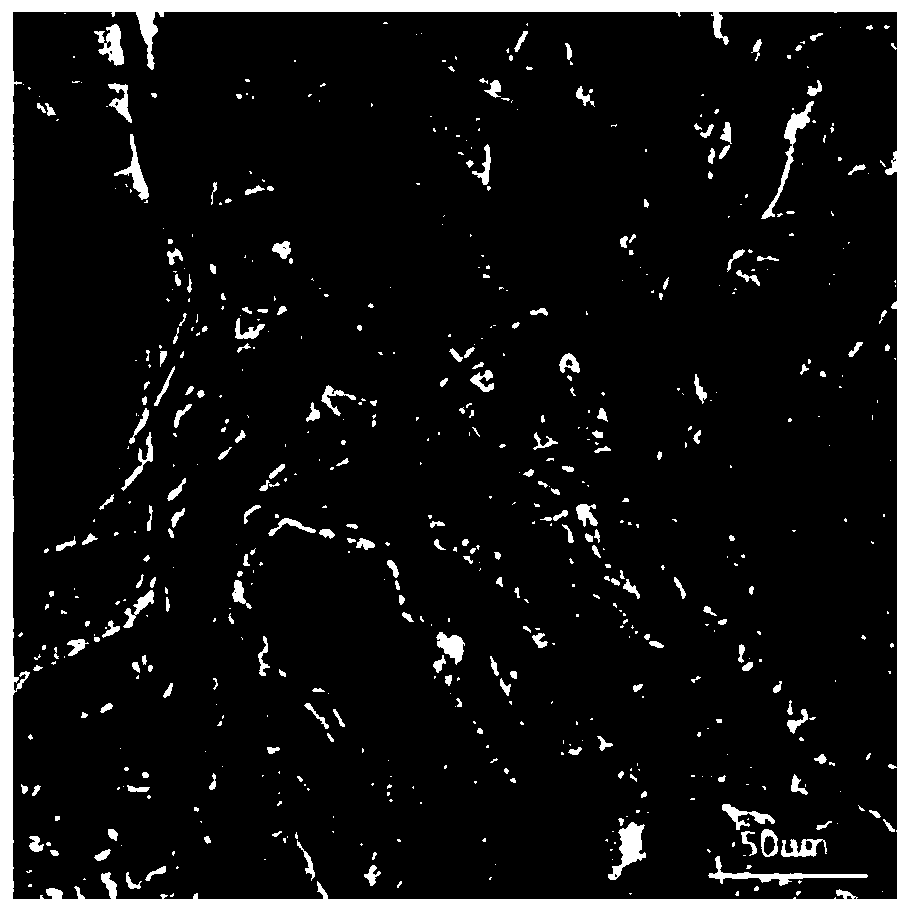Preparation method of highly dispersed NiCo alloy-graphene nanometer composite catalyst
A nanocomposite and graphene technology, applied in the field of electrochemistry, can solve problems such as difficulty in large-scale production, aggregation of nanoscale catalysts, and reduced mass transfer efficiency, and achieve novel preparation, high efficiency and long-term stability, and improved catalytic activity Effect
- Summary
- Abstract
- Description
- Claims
- Application Information
AI Technical Summary
Problems solved by technology
Method used
Image
Examples
Embodiment 1
[0020] A preparation method of highly dispersed NiCo alloy-graphene nanocomposite catalyst, comprising the following steps:
[0021] (1) Put citric acid and histidine in a beaker at a molar ratio of 1:1, and react at 200°C to obtain histidine-functionalized nano-graphene;
[0022] (2) Disperse graphene oxide in deionized water to obtain an aqueous solution, add the histidine-functionalized nano-graphene prepared in step (1) under stirring, disperse evenly by ultrasonic, adjust the pH to neutral and add chloride chloride drop by drop Nickel, cobalt chloride compound to no longer continue to produce precipitation, wherein the mol ratio of nickel chloride and cobalt chloride is 1:1, collect precipitation, wash with deionized water, centrifugal drying obtains nickel-cobalt-graphene oxide composite;
[0023] (3) The nickel-cobalt-graphene oxide composite obtained in step (2) was calcined in nitrogen at 600°C for 2 hours to obtain a NiCo alloy-graphene nanocomposite catalyst, and it...
Embodiment 2
[0026] A preparation method of highly dispersed NiCo alloy-graphene nanocomposite catalyst, comprising the following steps:
[0027] (1) Put citric acid and histidine in a beaker at a molar ratio of 1:1, and react at 200°C to obtain functionalized nano-graphene;
[0028] (2) Disperse graphene oxide in deionized water to obtain an aqueous solution, add the histidine-functionalized nano-graphene prepared in step (1) under stirring, disperse evenly by ultrasonic, adjust the pH to neutral and add chloride chloride drop by drop Nickel, cobalt chloride compound no longer continue to produce precipitation, wherein the mol ratio of nickel chloride and cobalt chloride is 1:10, collect precipitation, wash with deionized water, centrifuge and dry to obtain nickel-cobalt-graphene oxide composite;
[0029] (3) Calcining the nickel-cobalt-graphene oxide composite obtained in step (2) at 600° C. for 10 hours in argon to obtain a NiCo alloy-graphene nanocomposite catalyst.
Embodiment 3
[0031] A preparation method of highly dispersed NiCo alloy-graphene nanocomposite catalyst, comprising the following steps:
[0032] (1) Put citric acid and histidine in a beaker at a molar ratio of 1:1, and react at 200°C to obtain functionalized nano-graphene;
[0033] (2) Disperse graphene oxide in deionized water to obtain an aqueous solution, add the histidine-functionalized nano-graphene prepared in step (1) under stirring, disperse evenly by ultrasonic, adjust the pH to neutral and add chloride chloride drop by drop Nickel, cobalt chloride compound no longer continue to produce precipitation, wherein the mol ratio of nickel chloride and cobalt chloride is 10:1, collect precipitation, wash with deionized water, centrifuge and dry to obtain nickel-cobalt-graphene oxide composite;
[0034] (3) Calcining the nickel-cobalt-graphene oxide composite obtained in step (2) at 800° C. for 6 hours in neon gas containing less than 5% hydrogen to obtain a NiCo alloy-graphene nanocomp...
PUM
 Login to View More
Login to View More Abstract
Description
Claims
Application Information
 Login to View More
Login to View More - R&D
- Intellectual Property
- Life Sciences
- Materials
- Tech Scout
- Unparalleled Data Quality
- Higher Quality Content
- 60% Fewer Hallucinations
Browse by: Latest US Patents, China's latest patents, Technical Efficacy Thesaurus, Application Domain, Technology Topic, Popular Technical Reports.
© 2025 PatSnap. All rights reserved.Legal|Privacy policy|Modern Slavery Act Transparency Statement|Sitemap|About US| Contact US: help@patsnap.com


